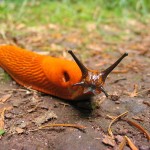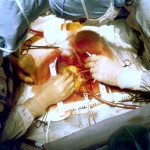They say that only time can heal a broken heart, but guess what Science says? Science says it’s glue! With numerous heart surgeries which occur every year, scientists wanted to invent an efficient method to make surgeries less complicated. Therefore researchers from MIT (Massachusetts Institute of Technology) and Boston Children’s Hospital invented a hydrophobic light-activated adhesive (HLAA). This glue has many benefits compared to traditional cardiac surgical methods such as staples and sutures. Unfortunately staples are not very safe to use because they can cause tissue damage and sutures can become complicated since the tissue has to be constantly realigned during the surgical procedure. The glue is a better alternative since it avoids tissue compression and friction that can damage delicate vessels.
Natural adhesives which are secreted by slugs, and sandcastle worms gave researchers the inspiration to create a synthetic adhesive called poly (glycerol sebacate acrylate), PGSA, which makes up the composition of the light activated glue. The natural adhesives are non-polar in nature since they are immiscible in water and they don’t easily wash away. PGSA consists of glycerol and sebacic acid which are metabolic intermediates used by cells in the body. Since these ingredients are naturally found within the human body they can be broken down easily without producing any toxic effects. The PGSA allows the glue to be both waterproof and elastic, two qualities which make it really efficient to work in a beating heart. Furthermore, once ultraviolet light is applied to the synthetic adhesive, it intertwines with the collagen in the heart and creates a strong seal which hardens within a time limit of 5 seconds. This property of the glue provides an advantage for long and complicated surgeries.
So far researchers have tested the glue for closing heart defects in lab rats and closing cuts in the arteries of pigs. Pigs and rats were chosen as tests because their hearts closely resemble human hearts. Researchers also used the glue to attach a biodegradable transparent patch on the thick inner wall of four pigs hearts and they discovered that after twenty four hours the patches still stayed in their exact position even when the pigs heart rates were increased tremendously. The extensive testing revealed that the glue is extremely strong and can therefore thrive amongst the pressures of a beating heart.
Researchers conclude that the glue cannot be used in human hearts at the moment because further testing still needs to be conducted. They believe that the glue will be beneficial not only for physicians but also for patients at the same time. It will reduce time for complicated surgeries and it will aid infants that are born with heart defects.
– Anupreet Sihra


Resources used:
(2) http://io9.com/this-worm-inspired-glue-can-mend-broken-hearts-1501073369
(3) http://www.popsci.com/article/science/glue-seals-heart-defects




5 responses to “Cure for Broken Hearts”